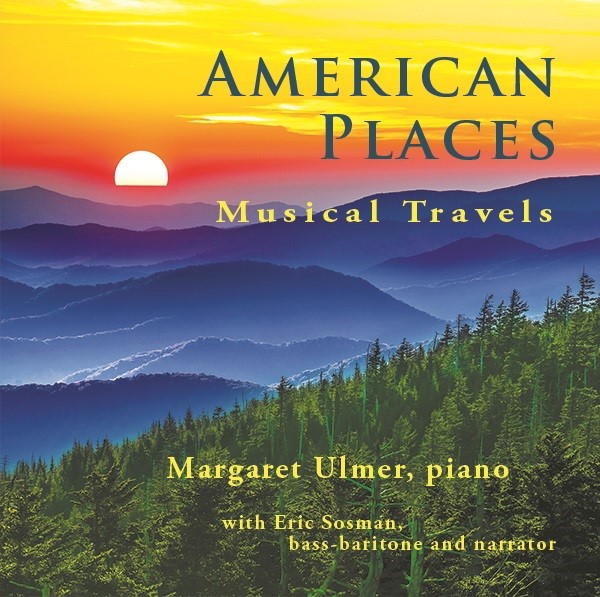Mozart's music at the World's Peace Jubilee in Boston in 1872
First performances in Massachusetts
First performances in Boston
First Performances in Stoughton
What is the oldest musical society in the U.S.A.?
AMP Links

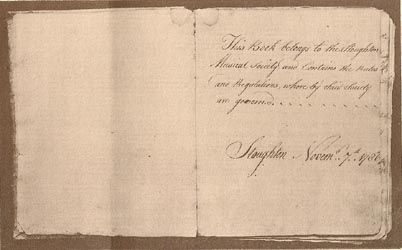
For teachers, students and researchers --
This multimedia computer disc is available --
"Peace and Music" - A New England Music Miscellany
(PTM 1022)
click here

Mozart's music at the World's Peace Jubilee

It was not the first U.S. performances but several Mozart works were featured during the "monster concerts" of the World's Peace Jubilee and International Music Festival held in Boston in 1872. One of them was the Queen of the Night coloratura aria from Mozart's last opera, The Magic Flute, sung in English and listed as "Day of Vengeance." It was performed on 29 June 1872 by one of the most esteemed singers of that time, Madame Pescha-Lautner with an orchestra of 2,000 musicians. In that same concert was the premiere of the "Jubilee Grand Concert Waltz" by Herr Johann Strauss, who was an invited guest and conducted his own composition. The Jubilee Waltz was dedicated to Patrick S. Gilmore, organizer of the Peace Jubilee and Music Festival. Another Mozart work was the beautiful prayer "O Isis und Osiris" from The Magic Flute. This arrangement had a religious text in English, which begins:"Almighty God! when round thy shrine." It was set for unison basses and four part chorus rather than bass soloist and men's chorus as in the original Mozart opera. This was the only Mozart work published in the Peace Jubilee choral music collection. Also included in the collection was a so-called "Gloria from Mozart's 12th Mass" which was not composed by Mozart. The composer of this "Gloria" is believed to be Austrian composer, Wenzul Mueller, who composed his Mass in G Major sometime after 1786.
First Performances in Massachusetts
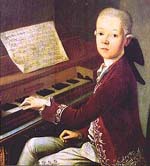
The works are listed in the chronological sequence of their first performances in the United States, or in Massachusetts from the 1840s to 1890s. The information was compiled from H. Earle Johnson's reference book, First Performances in America to 1900: Works with Orchestra, and from other documents.
America’s first prominent music critic, John Sullivan Dwight (1813-1893), founded the most important and influential music publication in America, Dwight’s Journal of Music (1852-1881).
This is what was published in that journal on Saturday, January 17, 1880 about Mozart’s Symphony in D Major:
The Mozart Symphony, one of several in D, and without Minuet, is a lovely composition, spontaneous, melodious, unmistakably clear in it intentions. You do not have to ask yourself whether you understand it, or whether you really like it, as you do after almost every recent work. There it stands, positive and perfect, which is only saying that it is by Mozart; with him it is no painful climbing to a would-be heaven of invention; in that heaven of harmony he lives and breathes at home, and what he composes is beyond criticism…With simpler means Mozart could express more than the moderns with their monster orchestras, and from fewer instruments evoke, not seldom, a more satisfying sonority; and so could Haydn.
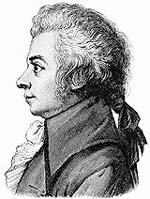
First performances
of
Mozart's music
in
Boston
+ = U. S. premiere =
6 works
++ = First performance in Boston =
14 works
Quotes from 19th century newspapers
and Dwight's Journal in red
Listed by year:
+Symphony No. 41 in C ("Jupiter"), K. 551 (1788) -
7 January 1843, Academy of Music, Henry Schmidt, conductor
++Symphony No. 40 in g minor, K. 550 (1788) -
21 December 1850, Tremont Temple, Musical Fund Society,
George J. Webb, conductor
-- This symphony was played from a manuscript copy presented by Charles Perkins
++Requiem in D minor, K. 626 (1791) -
18 January 1857, Handel and Haydn Society, Carl Zerrahn
Mme. d'Angri, Mrs. Long, Sig. Morelli, Mr. Arthurson, soloists
--- Many were drawn by Mozart's Requiem...Upon the whole it was a very successful performance --- Dwight's Journal, 24 January 1857
[Note: The Handel & Haynd Society now claims their first performance in Boston was in 1828]
++Piano Concerto No. 22 in Eb, K. 482 (1785) -
26 February 1859, Philharmonic Society, Carl Zerrahn, conductor
Benjamin J. Lang, piano (cadenza by Lang)
++Symphony No. 35 in D ("Haffner"), K. 385 -
30 November 1859, Boston Music Hall, Orchestral Union,
Carl Zerrahn, conductor
+Symphony No. 36 in C ("Linz"), K. 425 (1783) -
28 March 1860, Music Hall, Orchestral Union, Carl Zerrahn, conductor
++Clarinet Concerto in A, K. 622 (1791) -
5 March 1862, Mendelssohn Quintette Club, Thomas Ryan, clarinet
++Concerto for Two Pianos in Eb, K. 365 (1779) -
21 November 1867, Music Hall, Harvard Musical Association, Carl Zerrahn
Benjamin J. Lang and J.C.D. Parker, pianists
++Piano Concerto No. 26 in D ("Coronation"), K. 537 (1788) -
17 February 1870, Music Hall, Harvard Musical Association, Carl Zerrahn
Hermann Daum, piano (cadenza by Reinecke)
++Piano Concerto No. 15 in Bb, K. 450 (1784) -
2 January 1874, Music Hall, Harvard Musical Association, Carl Zerrahn
J.C.D. Parker, piano ["first time in Boston"]
++Piano Concerto No. 24 in C minor, K. 491 (1786) -
13 February 1874, Harvard Musical Association, Carl Zerrahn
Hugo Leonhard, pianist ["first time in Boston"]
--- It surely is not just the kind of work which a pianoforte virtuoso would choose for the first exhibition of himself as such; but, what is far better, he can show himself in it as a musician, artist and poetic interpreter, and that opportunity Mr. Leonhard improved in the happiest manner; and such an interpreter, being on the inside of the task, knows very well, what few on the outside suspect, what mastery of the whole technique and higher art of pianoforte playing is required to really interpret and convey the meaning and beauty of so fine a work ---
Dwight's Journal, 21 February 1874
++Violin Concerto No. 4 in D, K. 218 (1775) -
26 February 1874, Harvard Musical Association, Carl Zerrahn
Camilla Urso, violin
++Concerto for Flute and Harp in C, K. 299 (1778) -
7 November 1875, Music Hall, Thomas Orchestra
Carl Wehnrer and Adolphus Lockwood, soloists
++Sinfonia Concertante in Eb, K. 364 (1780) -
20 November 1875, Music Hall, Harvard Musical Association,
Carl Zerrahn, conductor;
C.N. Allen and H. Heindl, soloists
["first time in Boston"]
+Piano Concerto No. 21 in C, K. 467 (1785) -
16 February 1876, Music Hall, Theodore Thomas Orchestra
William Mason, piano
--- This (Concerto) from which we had expected much, did not somehow prove effective, perhaps because both music and interpreter were not in their right sphere. Mr. Mason's nice manipulation, and very even, finished, quiet style of execution which might have made it all delightful in a small room, seemed to lack force and vital accent here; it was like remembering music in one's sleep --- Dwight's Journal,
4 March 1876
Additional Comments:
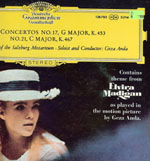
The serene Andante movement of this piano concerto has become best known by its subtitle: "Elvira Madigan."
This is a confusing designation. The subtitle is taken from the 1967 Swedish film which used the Mozart slow movement on its soundtrack. The problem isn't with the film -- it's with the record producers. The recording used in the film was by pianist Geza Anda and the Camerata Academica of the Salzburg Mozarteum. It received a Grand Prix Du Disque and remains one of the best recordings of this sublime piano concerto. Almost immediately after the film became a big hit, the record company (Deutsche Grammaphon) replaced the original LP album cover, which had a handsome old color print, with a cover showing the beautiful Pia Degermark [see illustration], the actress who played Elvira Madigan in the film. At least the LP cover stated that it contained the theme used in the film. But since then many record companies have largely ignored explaining that Elvira Madigan comes from the film NOT from Mozart. The record companies can make more money with that film subtitle on it instead of just the original Mozart title. A case of crass commercialism!
++Piano Concerto No. 23 in A, K. 488 (1786) -
19 December 1878, Music Hall, Harvard Musical Association, Carl Zerrahn
H.G. Tucker, piano ["first time in Boston"]
++Ein Mussicalischer Spass (A Musical Joke) for Strings and Horns, K.522
5 December 1879, Music Hall, Philhamonia Orchestra (or Boston Philharmonic), Bernard Listemann, conductor --
repeated on 8 January 1880 at Sanders Theatre in Cambridge, Massachusetts
+Serenade No. 12 in C, K. 388 (1782) -
22 March 1881, Music Hall, Philharmonia Orchestra
(or Boston Philharmonic), Bernard Listemann, conductor
---"Andante, Minuet, Finale" only - First time in America "
Dwight's Journal, 9 April 1881
+Serenade in Eb, K. 375 (1781) -
5 April 1895, Music Hall, Boston Symphony, Emil Paur, conductor
--- So rich in melody and harmony, so perfect in form and working out, in a word so full of genius is this modest little work that one felt none of that sugary, 'cloying' of the musical palette which is so often the effect of extended compositions of wind instruments -- William Apthorp, Boston Transcript, 8 April 1895
--- The Serenade was played in delightful fashion last evening. Once in a while it is good to hear such amiable music, but a little of it goes a long way. -- Boston Journal, 8 April 1895
+Symphony No. 25 in g, K. 183 (1774) -
27 October 1899, Music Hall, Boston Symphony Orchestra, William Gericke, conductor
--- exhumed by Gericke -- Boston Journal, 28 October 1899
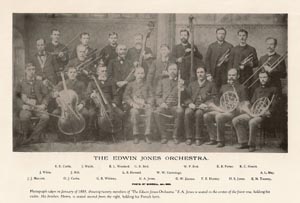
First Performances in Stoughton
+++ = First performance in Stoughton = 4 works
Though it had been performed in Boston a number of times,
the first known performances of Mozart music in Stoughton, Massachusetts are:
+++Overture to The Magic Flute
9 June 1886, Stoughton Town Hall, Stoughton Musical Society,
Hiram Wilde, conductor; Edwin Jones Orchestra
It was performed in the Centennial Concert of the Stoughton Musical Society. But it was not the only work in that concert. The featured work was Haydn's oratorio, The Creation, which was performed again in 1986 for their Bicentennial Concert.
This is an excerpt from the local newspaper:
At 10 o'clock [a.m.], the orchestra of 48 performers, under the leadership of E.A. Jones of Stoughton, and a chorus of 250 voices, the whole under the direction of Mr. Hiram Wilde of Randolph, were in their places, ready for the commencement of the celebration of the centennial of our venerable and honored Society. At the fall of the baton in the hands of Mr. Wilde, the orchestra sounded forth Mozart's overture, Magic Flute, with a melody that was pleasing to the ear and appropriate to the occasion, while the audience applauded in the heartiest manner. ---
Stoughton Sentinel newspaper, June 1886
Ten years later, the Stoughton Sentinel newspaper column "Sentry Box Notes" mentions the weekly Friday "instrumental nights" at the home of violinist and composer, Edwin Arthur Jones.
Among the works performed in 1896 were these first performances of Mozart's music:
+++Clarinet Quintet in A Major, K. 581
+++Divertisement for String Quintet and Two Horns
+++String Quartet in D minor [probably K. 421]
The newspaper columnist also mentions that "the quintets of Mozart and Mendelssohn are special favorites at the instrumental nights in the home of Edwin A. Jones."

What is the oldest musical society
in the United States of Americ?
Over the years much discussion and disagreement has taken place over which organization is the oldest musical society in the United States.
Musicologist H. Earle Johnson explained it this way:
The situation is clear enough if properly worded:
Stoughton has the oldest singing society, and Boston the oldest oratorio society. Stoughton delights in keeping alive early American music; Boston, from the beginning, eschewed the psalm tune era and hailed the oratorio form as expounded by Handel and Haydn.
--- HALLELUJAH, AMEN! The Story of the Handel and Haydn Society of Boston, Boston: Bruce Humphries Publishers, 1965, page 17.

The Old Stoughton Musical Society is now the
oldest choral (or singing) society in the United States,
founded on 7 November 1786,
one year before the U.S. Constitution was written.
Though the OSMS has performed music by some European composers over the past centuries, most of the music performed has been by
American composers, especially from New England.
For more information about this musical society,
click on this link to
Singing Stoughton
If you have questions or comments,
write to:
Mozart in Massachusetts
Related AMP Links
Music in Massachusetts
New England Music Archive
Stoughton Music Heritage Series
Please remember to credit this website!
If you use any information on this page
for
any publication or website,
please give credit to this site,
American Music Preservation.com
For any comments or questions, write to:

Please help support
the Center for American Music Preservation (CAMP)
Order this enjoyable limited edition CD
